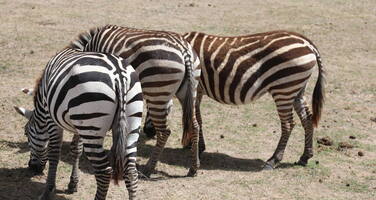Ngorongoro Conservation Area
Factors affecting the property in 2000*
- Ground transport infrastructure
Factors* affecting the property identified in previous reports
- Shortcomings in the management and lack of resources (issues resolved)
- Residents allowed to grow crops inside the World Heritage site (issue resolved)
- Construction of an access road
UNESCO Extra-Budgetary Funds until 2000
$79,000 to date plus $275,000 IUCN support in 1994 (funded by Germany)
International Assistance: requests for the property until 2000
Total amount approved : 216,132 USD
Missions to the property until 2000**
Information presented to the Bureau of the World Heritage Committee in 2000
Previous deliberations:
Twenty-third session of the Committee – paragraph X.28 and Annex VIII.
New information: The Centre is in contact with the State Party to monitor progress with the process for investigating options available for the construction of an access road to Ngorongoro. No new information has been received at the time of the preparation of this document.
Action Required
Conservation issues presented to the World Heritage Committee in 2000
No new information has been received by the Secretariat concerning progress in the process for investigating options available for the construction of an access road to Ngorongoro and the feasibility study reported to be underway in relation to the route. The Centre sent a letter to the State Party dated 10 July 2000 informing on the decision of the Bureau, but a reply has not been received at the time of preparing the Bureau’s report. However, IUCN has noted in the update that Mak-Consult, the contractor, has produced a detailed design of the road to tarmac it from Makuyuni to the Loduare Gate of the Ngorongoro Conservation Area, and that a document on the proposal will be submitted to the Government of Tanzania in late 2000. An Environmental Impact Assessment was carried out on the various proposed routes for the planned access road and a decision made that the road should avoid environmentally sensitive areas. The road will be low speed and drifts will be used to reduce the speed.
Summary of the interventions
Decisions adopted by the Committee in 2000
24 BUR IV.B.41
Ngorongoro Conservation Area and the Serengeti National Park (United Republic of Tanzania)
The Bureau was read a letter of appreciation received from the Director General of Tanzania National Parks dated 20 June 2000 in which the State Party informed the Centre that the Tanzania National Parks received safely the two vehicles provided by the twenty-third session of the Bureau (July, 1999) for Kilimanjaro and Serengeti National Parks. The letter said that the vehicles are being used for the management of the Kilimanjaro and Serengeti National Parks to improve the fire monitoring patrols, and resources such as the veterinary services, studies in quantity and quality of water for animals and ecological monitoring in general. This support for Serengeti as a vast park, has been a morale booster for the Park staff. The Director General of the Tanzanian Park Agency thanked the World Heritage Centre, and the Bureau for this assistance.
As regards the road to Ngorongoro, the Bureau noted that the Centre is in contact with the State Party to monitor progress in the process for investigating options available for the construction of an access road to Ngorongoro and that no new information has been received.
The Observer of Tanzania thanked the World Heritage Centre for the support provided to his country, and assured the Bureau that Tanzania will communicate with the Centre concerning the construction of the road.
Having been informed that IUCN understood that a feasibility study is underway in relation to the route of the road, the Bureau recommended that more information be sought from the State Party on this issue for the twenty-fourth extraordinary session of the Bureau.
24 COM VIII.iii
State of conservation reports of natural properties noted by the Committee
State of conservation reports of natural properties noted by the Committee
Belovezhskaya Pushcha/Bialowieza Forest (Belarus/Poland)
Pirin National Park (Bulgaria)
Dja Faunal Reserve (Cameroon)
Gros Morne National Park (Canada)
Canadian Rocky Mountains Parks (Canada)
Comoe National Park (Côte d'Ivoire)
Galapagos Islands (Ecuador)
Komodo National Park (Indonesia)
Lorenz National Park (Indonesia)
Mount Kenya National Park/Natural Forest (Kenya)
Te Wahipounamu - South West New Zealand (New Zealand)
Arabian Oryx Sanctuary (Oman)
Huascarán National Park (Peru)
Danube Delta (Romania)
Lake Baikal (Russian Federation)
Niokolo-Koba National Park (Senegal)
Doñana National Park (Spain)
Sinharaja Forest Reserve (Sri Lanka)
Bwindi Impenetrable Forest (Uganda)
Gough Island (United Kingdom)
Ngorongoro Conservation Area and the Serengeti National Park (United Republic of Tanzania)
Ha Long Bay (Vietnam)
Mosi-oa-Tunya/Victoria Falls (Zambia/Zimbabwe)
The Bureau may wish to adopt the following decision and transmit it to the Committee for noting:
“The Bureau requests the Centre and IUCN to continue monitoring this site, and invites the State Party to provide reports to the Centre on a regular basis and to deposit at the Centre a copy of both the management plan and the Environmental Impact Assessment Study.”

Exports
* :
The threats indicated are listed in alphabetical order; their order does not constitute a classification according to the importance of their impact on the property.
Furthermore, they are presented irrespective of the type of threat faced by the property, i.e. with specific and proven imminent danger (“ascertained danger”) or with threats which could have deleterious effects on the property’s Outstanding Universal Value (“potential danger”).
** : All mission reports are not always available electronically.

